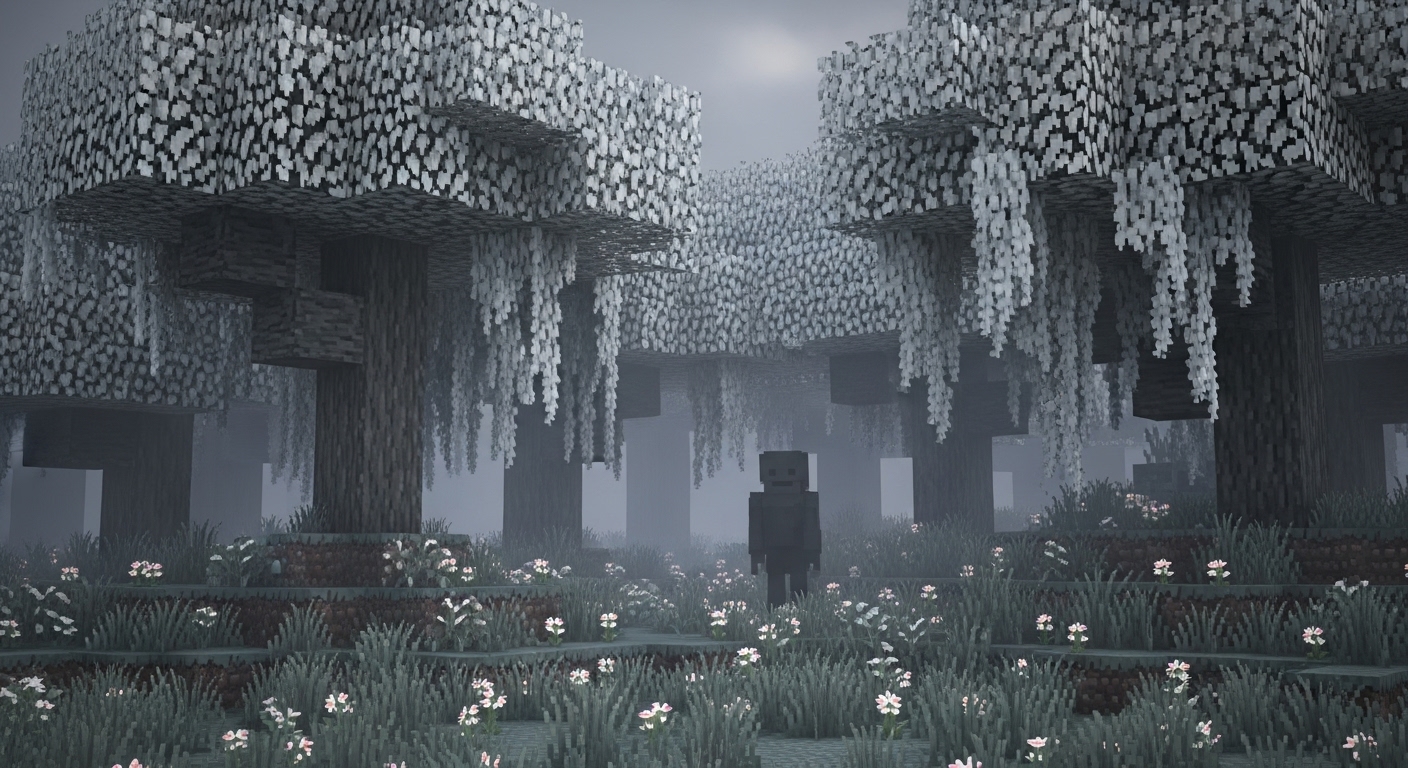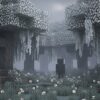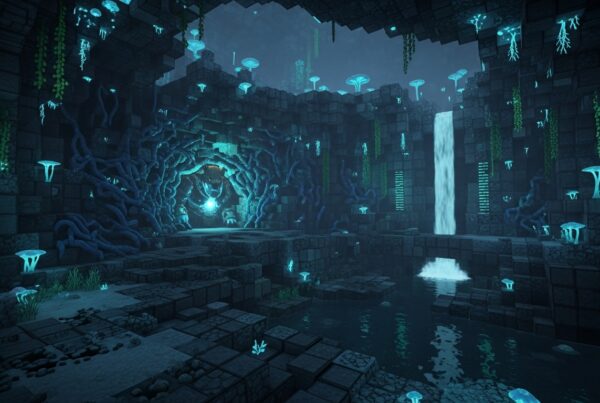The Pale Garden biome is one of the most atmospheric and thrilling new additions in the Minecraft 1.21 “Tricky Trials” (also referenced as “The Garden Awakens”) update. With its ashen grey trees, eerie new mobs, and rare vegetation, the Pale Garden offers a unique experience that blends exploration, survival challenge, and creative possibilities.
Whether you’re hunting for its special pale oak wood, tracking down the haunting Creaking enemies, or building an otherworldly base, this guide covers everything you need: terrain, flora, mobs, resources, seeds, and survival/building strategies.
What Is the Pale Garden Biome?
The Pale Garden is a variant of the Dark Forest-type biome, distinguished by its muted colour palette — pale grey bark, desaturated leaves, and an overall ghostly vibe. It’s generated inside or adjacent to the typical Dark Forest biome rather than as a completely independent biome type.
Key identifiers include:
- Climate values: temperature roughly 0.70 and downfall approximately 0.80.
- Generation context: often embedded within the Dark Forest biome, sometimes in small pockets or larger swaths.
- Visual/style: tree trunks are pale-coloured, leaves and saplings have a soft grey-green hue, ground may have mossy covers or pale grass. It feels like a “garden of shadows” rather than a bright forest.
Pale Garden Biome Features
Terrain & World Generation
- Typically the terrain is similar to Dark Forest: rolling hills, dense tree cover, and occasional clearings.
- This biome might spawn in discreet patches (small areas) rather than as vast expanses — making it rare to find.
- Because it emerges from Dark Forest terrain, you may find moody lighting, thicker canopies blocking sunlight, and plenty of uneven ground for hidden caves.
Flora & Vegetation
The Pale Garden is rich in vegetation that is unique to it or strongly associated with it:
- Pale oak trees: A new wood variant with light-toned bark and leaves.
- Pale saplings/leaves: These grow from the trees and allow you to bring the aesthetic elsewhere.
- Pale moss & hanging pale moss: Decorative blocks found in this biome, great for aesthetic builds and landscaping.
- Eyeblossoms: Night-blooming flowers that glow faintly and add to the haunting look of the biome.
- Soft grasses, subdued groundcover, and pale-toned undergrowth that differentiate it from vibrant forest or flower biomes.
Resources You Can Find
The Pale Garden provides a number of desirable resources for both survival and creative building:
| Resource | Description | Notes |
|---|---|---|
| Pale oak logs/planks | New wood type for building & crafting | Renewable via saplings |
| Pale leaves/blocks | Decorative building blocks | Shear-collectable |
| Pale moss / hanging moss | Decorative, gives mature “overgrown garden” feel | Useful for landscaping |
| Eyeblossoms | Rare flowers, often drop unique dyes or decorative use | Glow at night |
| Standard drops | Saplings, sticks, leaves from pale oak trees | As usual for tree harvesting |
Because passive animals do not naturally spawn in the Pale Garden (see below), you may need to import or bring animals if you plan farms.
Mobs in the Pale Garden Biome
Passive & Neutral Mobs
A key distinguishing feature: in the Pale Garden biome, animal mobs do not spawn naturally (e.g., cows, sheep, pigs). This means natural food and leather/fur sources may be absent—plan accordingly.
Hostile Mobs
Standard hostile mobs appear at night or in dark places (zombies, skeletons, creepers, etc.), but the haunting new addition is:
The Creaking
- A unique hostile mob that only appears in Pale Garden biomes.
- It remains motionless while you look at it but moves when you look away — reminiscent of the “Weeping Angels” effect.
- Cannot be defeated by ordinary means alone: you must locate and destroy the “Creaking Heart” block hidden in the biome to halt their threat. (The Heart acts as their spawn anchor/weak point.)
- Builds tension and adds a survival challenge component to the biome.
Unique or Rare Mobs / Mechanics
- The Creaking Heart block: Often hidden underground but still within the biome’s footprint. Once destroyed, Creaking spawn less frequently or stop entirely for the area.
- Because of the lack of animals and the presence of Creaking, the biomes function more like “hazard zones” than standard peaceful woods.
- The biome may feature special loot or blocks tied to these mechanics (check patch notes or datapacks for version-specific drops).
How to Survive and Thrive in the Pale Garden
Exploration Tips
- Go in prepared: bring strong gear, ample food (since no natural animals), and torches/light sources.
- Use axes for pale oak harvesting; use shears for pale leaves and decorative moss blocks.
- Be aware of hidden caves and the motion-sensing Creaking — keep your view steady!
- Mark your path: the aesthetic can be disorienting (grey tones everywhere).
- If you locate the Creaking Heart, clear the area around it and destroy it to make the biome safer.
Building in the Pale Garden
- Embrace the subdued palette: pale oak wood fits perfectly into gothic, haunted, or fantasy themed builds.
- Use moss and hanging moss blocks to give overgrown garden vibes.
- Use glow-berries or lanterns to offset darkness without interfering with the aesthetic bloom of eyeblossoms.
- Because animals don’t spawn naturally, if you want animal farms, consider building them just outside the biome or bring animals in with boats/trails.
Farming & Resource Harvesting
- Harvest pale oak saplings and leaves to propagate your own pale oak forest outside the biome.
- Flower and eyeblossom farming: Use bone-meal on suitable ground to increase flower growth for decoration/dye.
- For food/farming: since animals are absent, rely on crop farms, fish from nearby water biomes, or import animals.
- Light your builds adequately to prevent Creaking spawning in edges or subterranean areas of your base.
Generation Locations & Biome Rarity
- The Pale Garden is moderately to highly rare and often spawns as smaller patches within or adjacent to Dark Forest biomes.
- Because of its rarity and size, finding one might require exploring or using seed analysis tools.
- Best chance: search Dark Forest biomes, use world-map viewers, or use “/locate biome minecraft:pale_garden” (Java Edition).
- Because animal mobs don’t spawn, you might note transitions from typical Dark Forest into the distinct pale-toned tree area as you locate it.
Best Minecraft Seeds With Pale Garden Biomes (Java Edition)
Here are real, community-confirmed seeds for the Pale Garden biome in Minecraft 1.21+:
| Seed Code | Highlight |
|---|---|
| 2668945730408983764 | Giant Pale Garden biome + Village at spawn |
| 1205583635397900013 | Pale Garden at spawn, adjacent village & other structures |
| 6581870304992025122 | “Pale Frost Garden” — Pale Garden surrounded by frozen peaks |
| -8970044548118636760 | Spawn directly in large Pale Garden (near lake) |
Note: Always double-check version (Java 1.21+), and coordinates may vary for Bedrock Edition.
Comparison to Similar Biomes
| Biome | Similarities | Key Differences |
|---|---|---|
| Flower Forest | Rich vegetation, decorative potential | Pale Garden uses desaturated palette & lacks animals |
| Cherry Grove | Aesthetic-focused, tree-rich | Cherry uses pink blooms; Pale is grey/pale + hazards |
| Dark Forest | Dense tree cover, similar terrain generation | Pale Garden is its variant with unique blocks/mobs |
| Forest / Regular Woods | Basic tree ecosystem, animal spawns | Pale Garden: no animals, new blocks/mobs |
Frequently Asked Questions
Q: Are animal mobs completely absent in the Pale Garden?
Yes. Passive animal spawning does not occur naturally within the Pale Garden biome. You’ll need to bring animals in for farms or resources.
Q: How do I deal with the Creaking enemies?
Locate and destroy the Creaking Heart block within the biome. Once destroyed, the spawn of Creaking in that area will stop or significantly decrease.
Q: Can I grow pale oak trees outside the Pale Garden?
Yes. Harvest pale oak saplings from the biome, take them elsewhere, and plant them with sufficient light. They will grow naturally like standard trees.
Q: What is the best way to find a Pale Garden biome?
Explore Dark Forest biomes, use world map viewers or commands (Java), check seed lists, and look for the pale-toned trees and terrain shift.
Q: Are there unique loot or structures inside the Pale Garden?
While standard structures rarely spawn inside the Pale Garden, some seeds embed structures such as Woodland Mansions adjacent to or within the biome. Also the new blocks (pale moss, eyeblossoms) and Creaking mechanics add unique gameplay.
Conclusion
The Pale Garden biome is one of Minecraft’s most evocative and rewarding new additions. With its haunting beauty, novel wood types, unique flora, and challenging mobs, it offers a blend of creativity and survival thrills. Whether you’re harvesting pale oak to build a masterpiece, farming eyeblossoms to decorate your world, or braving the Creaking beneath the grey canopy — the Pale Garden promises a fresh and memorable Minecraft experience.






